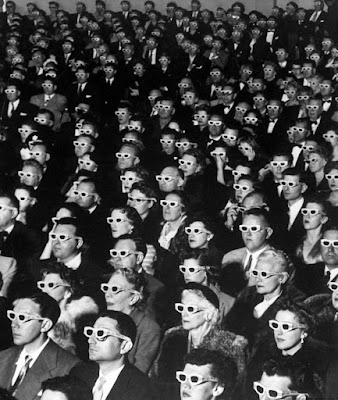I'll tread lightly upon this subject of 3D for realizing there are experts that know it chapter/verse, and so humbly invite same to expand upon or correct data gathered here. Just understand that 3D represents a noble tradition of screw-ups and breakdowns, my own in respectful observance of that. I embark upon multi-posts about the process, mindful not to exceed an initial three (more will follow later) as we’ve all known fatigue too much 3D can inflict. Like a lot (most?) of you, I’ve never seen it decently presented. By that I mean with two projectors side-by-side running in perfect synchronization.
I'm for dealing out modern third dimensions this trip. The only sampling I’ve seen anyhow was a handful of ear-jangling IMAX shorts about jungle safaris. What I’m for exploring is so-called primitive 3D that excited patrons during 1953 and much of ’54. I was born during the boom and feel closer to it for that. The Egyptian Theatre in
Moviegoing travels brought me twice to House Of Wax on single-strip reissues (1972 and 1983), both botched. Other than that, there was Revenge Of The Creature with 16mm reds and greens having faded, thus killing the 3D effect, and more recently the challenge of DVD-delivered Spooks, with The Three Stooges. Yet I’m rarin’ to go for 3D after boning up on 50’s showman efforts to get a rope ‘round a novelty most of them figured for the flash in the pan it turned out to be.
Old timers in the business said 3D reminded them of the mess that was Vitaphone, and here they were twenty-five years later reliving sync-up nightmares. Each to a man knew what a minefield that could be. There was always option of letting the craze pass, but what of lines and epic grosses your opposition’s fielding down the street? Exhibitors sought elixir to bring people back into theatres. Hit movies continued declining in number as solid attractions on TV carved inroads. Wouldn't you elect to stay home and watch Lucy or maybe Martin and Lewis doing the Colgate Comedy Hour over going out and paying admission for a commonplace feature?
By late 1952, most were voting the tube. Whoring out to a gimmick was desperation’s last resort for an industry down on canvass and taking the count. Independent producer Arch Oboler was an experimenter from radio who guessed 3D might click at feature-length. Maybe others considered it before, but he was first to throw dice with monies borrowed and bookings scavenged where management would gamble with an unsure thing. Two Paramount theatres in
 |
| Arch Oboler at Bwana Devil's Hollywood Opening with Stereo-Realist Lobby Display |
Just as industry watchers wondered if The Jazz Singer might be a fluke back in 1927, so too did studios flinch over dives into 3D. Another independent with spring in his step was Sol Lesser, always quick to move in on someone else’s good thing. A British developer leased him rights to a process called Tri-Optican and a handful of shorts utilizing its depth (including a documentary, cartoon, ballet, and an abstract film, according to Boxoffice). Some said the latter looked better than Oboler’s Natural Vision. Lesser’s Tri-Opticon was
Seizing initiative as they had with talkies, Warner Bros. announced shooting would begin January 15, 1953 on Wax Works in Natural Vision 3-D. They understood this was a race for what Jack Warner called a fast dollar at the box office. Directors of the Theatre Owners of America exhibitors group convened in January 1953 to discuss future possibilities of 3-D, and provided a print could be secured, to inspect Bwana Devil as well. Sol Lesser was meanwhile delivering equipment and accessory packages to theatres booked for Tri-Opticon. They’d need a “metalized” screen, a coupling device for interlocking projectors, and Polaroid glasses, these being reusable provided they were sterilized after each show.
 |
| Paramount's Adolph Zukor Being Prepared for His 3-D Debut |








